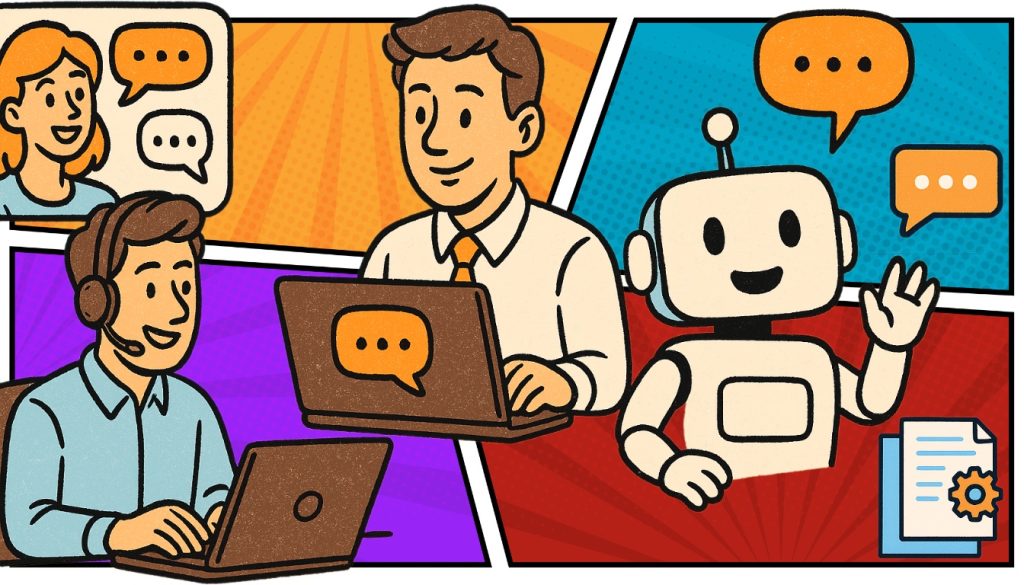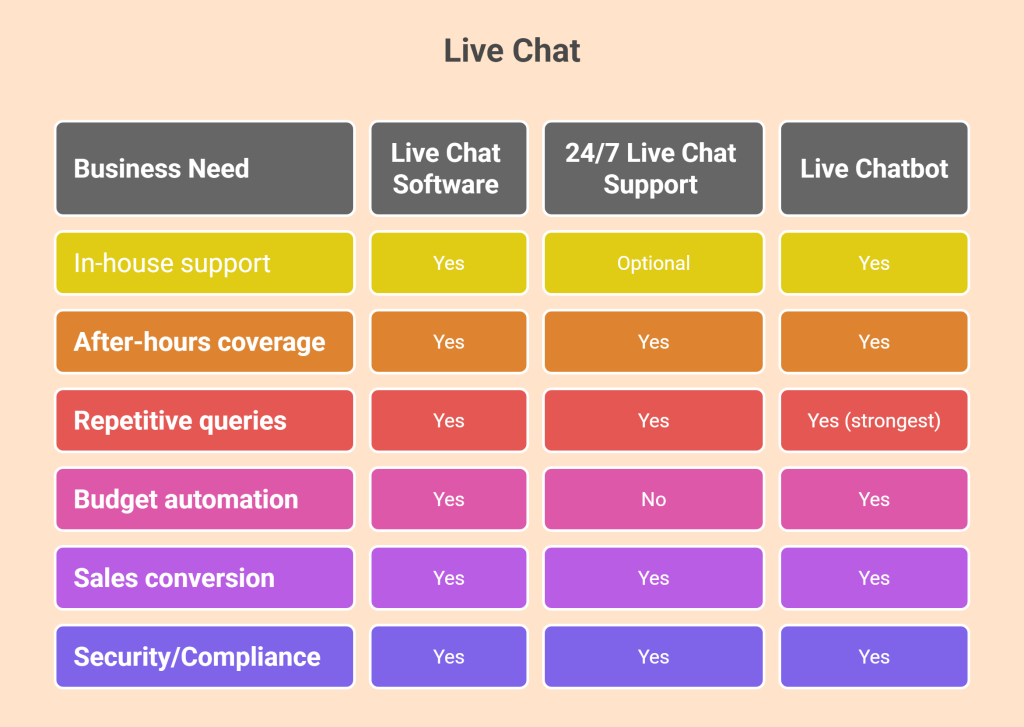Let’s talk live chat. If you’ve ever landed on a website and seen that little chat bubble pop up with “Need help?”—that’s live chat software at work. And if you’re running a business (especially online), understanding how this works can save you time, money, and a lot of customer frustration.
This article will explain the answer to our question today “How does live chat work?”, why it’s more powerful than it looks, and how tools like software, support agents, and chatbots all play different roles. I’ll also give you a quick introduction to LiveHelpNow, a platform that covers all these bases really well. But first, let’s start with the basics.

What Is Live Chat?
Live chat is that handy little window on a website where visitors can get real-time help from a person—or sometimes a bot. It’s fast, convenient, and doesn’t require picking up the phone (which most of us love to avoid). Live chat also adds a personal touch that other channels often lack.
Turns out, 41% of customers prefer live chat over other service channels, and it has higher satisfaction rates that is way ahead of phone (44%) and email (61%). It makes sense—no waiting on hold, and you can keep browsing while chatting
Three Ways to Do Live Chat
Live Chat Software
What It Is:
Live chat software is basically your customer service control center. It lets your team talk to website visitors, answer questions, solve problems, and even close sales—all from one screen. The good ones also integrate with your CRM, automate repetitive replies, and give you analytics to see how your team’s doing.
Think of it as the friendly receptionist who never sleeps, never gets tired, and knows exactly how to route a message. LiveHelpNow is one example of this—packed with smart features but still easy to use.
Key Features:
- Proactive chat invites that engage customers before they leave.
- Sneak-peek so agents can see what the customer is typing.
- Canned responses, file sharing, translation tools.
- Whisper mode for private coaching between agents and supervisors.
- Built-in dashboards and performance tracking.
- Integrations with CRMs, e-commerce, and social platforms.
- HIPAA and PCI compliance (a must if you’re in healthcare or finance).
How It Helps:
This kind of tool saves time and makes your support team way more efficient. It can even bump up your sales—live chat leads often convert at higher rates, and customers spend more per purchase. Plus, you’ll reduce your support costs compared to phone-based service.
24/7 Live Chat Support
What It Is:
Maybe you don’t have a full support team—or any team. That’s where 24/7 live chat support services come in. These are real, trained humans who chat with your customers for you, even while you sleep.
This is perfect if you’ve got international customers, run an e-commerce site, or just want coverage after business hours. Companies like LiveHelpNow offer this as a plug-and-play service so you don’t have to build your own support team from scratch.
Key Features:
- Real people handling real-time chats 24/7.
- Integrated with your systems so nothing gets lost.
- Escalation to help desk or ticketing if needed.
- Ongoing training and monitoring to keep quality high.
How It Helps:
Simple: you don’t miss leads or leave customers hanging. And that’s a big deal in today’s market. With professional agents covering your chat, you keep customers happy—and that keeps them coming back.
Live Chatbot
What It Is:
Chatbots aren’t here to replace your team—they’re here to handle the stuff your team shouldn’t be wasting time on. Think: “What’s your return policy?” or “How can I reset my password?”
A chatbot can answer these instantly, 24/7. And if something more complex comes up, it hands things off to a human. LiveHelpNow’s chatbot, Hue, is a great example. It’s powered by GPT and other AI tools, and it plugs right into your support workflow.
Key Features:
- Understands natural language (it actually sounds human).
- Pulls answers from your site, FAQs, or knowledge base.
- Handles lead capture with secure forms.
- Routes tricky questions to your live team.
- Comes with dashboards to track performance.
How It Helps:
Bots like Hue can deflect up to 80% of your support volume. Companies can integrate these chatbots as part of comprehensive AI business solutions that automate multiple customer service processes beyond just live chat support. That means your team can focus on the conversations that actually need a human touch. And because it’s running 24/7, customers get help the moment they need it—not hours later.
How to Know Which One’s Right for You

What’s Trending Now (and What’s Coming Next)
On July 14, 2025, something pretty wild happened in the world of customer service. A user tested out Perplexity’s new Comet browser, and it handled an entire FedEx support chat by itself—no human involved. It tracked a package, chatted with a live agent, and managed the whole thing autonomously. This marks one of the first real-world examples of AI-to-AI communication being used in a public customer service setting.
Comet is powered by Perplexity’s advanced AI assistant, and while it handled simple tasks like tracking just fine, it still struggled with more complex stuff like booking a pickup. So it’s not quite replacing support teams yet—but it’s definitely shaking things up.
Looking ahead
Looking ahead, we’ll likely see voice-enabled chat, biometric logins, and hyper-personalized support powered by smart analytics. The future of live chat? Think more automation, more personalization, and less waiting around.

Why All This Matters
Efficiency & Cost Savings
Live chat cuts down on phone calls, shortens response times, and lets your team help more people in less time. Bots take care of the basics. Humans handle the hard stuff.
Better Experience
Customers love quick, helpful, and human-feeling responses. Whether that comes from a person or a smart bot doesn’t matter as much as you think—as long as the job gets done.
Scalability
Whether you’re a one-person shop or a growing business, these tools scale with you. And you don’t have to compromise quality along the way.
Conclusion
If you’re just getting started with live chat—or looking to make yours work smarter—there are plenty of options out there. LiveHelpNow happens to be one that does it all: software, support agents, and chatbots under one roof.
No pressure—but if you’re curious, it’s worth checking out.




